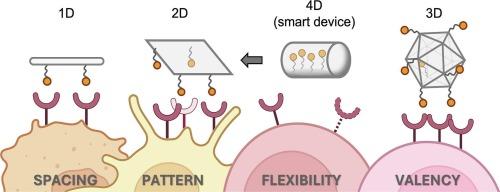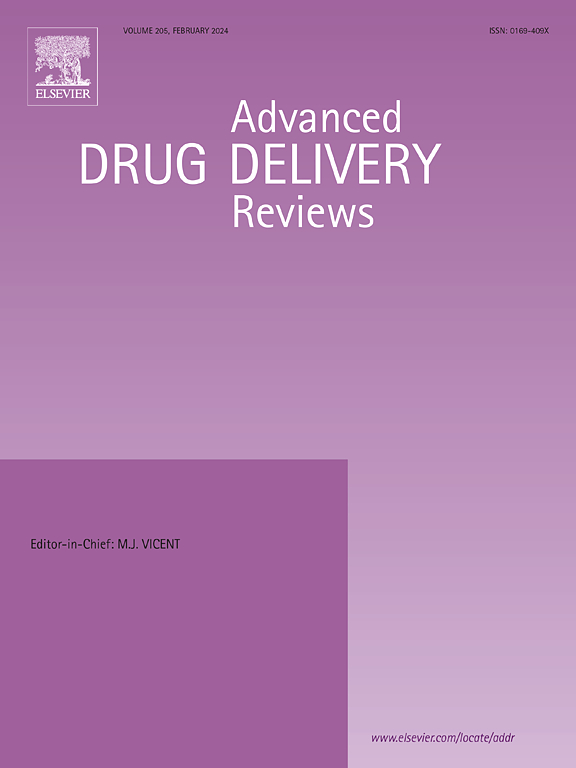基于dna纳米材料的生物界面多价工程
IF 17.6
1区 医学
Q1 PHARMACOLOGY & PHARMACY
引用次数: 0
摘要
在生物学中,功能很少依赖于单一的结合事件。无论是细胞信号传导、免疫识别还是粘附,大多数过程都依赖于同时发生且距离很近的相互作用的临界密度。这种多价性确保了鲁棒性、特异性和可调性,这些特征是单分子靶向方法经常无法复制的。因此,人们对能够模拟或利用生物界面上这些自然相互作用模式的工程多价系统越来越感兴趣。基于dna的纳米材料具有精确的可编程性和结构控制能力,已成为该领域的有力工具。它们使配体的空间组织达到纳米分辨率,不仅增强了结合亲和度,而且还允许设计几何依赖和上下文敏感的靶向策略。这种能力标志着从传统的多价结合向我们在这里定义的多价工程的概念转变:基于受体组织、密度和当地环境,对配体排列进行深思熟虑的空间规划,以控制生物结果。本文讨论了生物界面多价性的基本原理,重点介绍了dna激活设计策略的最新进展,并探讨了这种新兴的多价性工程框架如何推动诊断、治疗和合成生物学的新应用。我们还概述了在复杂的体内环境中实现这些系统的全部潜力必须解决的主要挑战。本文章由计算机程序翻译,如有差异,请以英文原文为准。


Multivalent engineering of bio interfaces with DNA-based nanomaterials
In biology, function rarely depends on a single binding event. Whether it’s cell signaling, immune recognition, or adhesion, most processes rely on a critical density of interactions that occur simultaneously and in close proximity. This multivalency ensures robustness, specificity, and tunability, features that single-molecule targeting approaches often fail to replicate. As a result, there is growing interest in engineering multivalent systems that can mimic or exploit these natural interaction patterns at biointerfaces. DNA-based nanomaterials, with their precise programmability and structural control, have emerged as powerful tools in this space. They enable the spatial organization of ligands at nanometer resolution, not only enhancing binding avidity but also allowing for the design of geometry-dependent and context-sensitive targeting strategies. This capability marks a conceptual shift from traditional multivalent binding toward what we define here as multivalent engineering: the deliberate spatial programming of ligand arrangements to control biological outcomes based on receptor organization, density, and local context. This review discusses the fundamental principles of multivalency at biointerfaces, highlights recent advances in DNA-enabled design strategies, and explores how this emerging framework of multivalent engineering is driving new applications in diagnostics, therapeutics, and synthetic biology. We also outline the major challenges that must be addressed to realize the full potential of these systems in complex in vivo environments.
求助全文
通过发布文献求助,成功后即可免费获取论文全文。
去求助
来源期刊
CiteScore
28.10
自引率
5.00%
发文量
294
审稿时长
15.1 weeks
期刊介绍:
The aim of the Journal is to provide a forum for the critical analysis of advanced drug and gene delivery systems and their applications in human and veterinary medicine. The Journal has a broad scope, covering the key issues for effective drug and gene delivery, from administration to site-specific delivery.
In general, the Journal publishes review articles in a Theme Issue format. Each Theme Issue provides a comprehensive and critical examination of current and emerging research on the design and development of advanced drug and gene delivery systems and their application to experimental and clinical therapeutics. The goal is to illustrate the pivotal role of a multidisciplinary approach to modern drug delivery, encompassing the application of sound biological and physicochemical principles to the engineering of drug delivery systems to meet the therapeutic need at hand. Importantly the Editorial Team of ADDR asks that the authors effectively window the extensive volume of literature, pick the important contributions and explain their importance, produce a forward looking identification of the challenges facing the field and produce a Conclusions section with expert recommendations to address the issues.

 求助内容:
求助内容: 应助结果提醒方式:
应助结果提醒方式:


